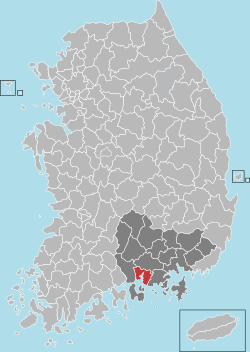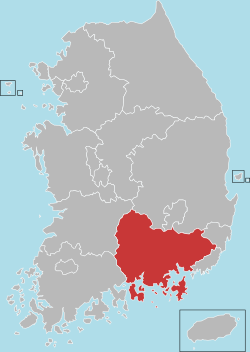Sacheon
Sacheon (Korean pronunciation: [sa.tɕʰʌn]) is a city in South Gyeongsang Province, South Korea. Sacheon's chief fame comes from its being the site of two naval battles in the Seven Year War.
Sacheon 사천시 | |
|---|---|
Municipal City | |
| Korean transcription(s) | |
| • Hangul | 사천시 |
| • Hanja | 泗川市 |
| • Revised Romanization | Sacheon-si |
| • McCune-Reischauer | Sach'ŏn-si |
 Emblem of Sacheon | |
 Location in South Korea | |
| Country | |
| Region | Yeongnam |
| Administrative divisions | 1 eup, 7 myeon, 6 dong |
| Area | |
| • Total | 396.99 km2 (153.28 sq mi) |
| Population | |
| • Total | 114,556 |
| • Density | 288.6/km2 (747/sq mi) |
| • Dialect | Gyeongsang |
The city as it now exists results from the merging of Sacheon-gun and Samcheonpo-si in 1995. The northern part of the city is called Sacheon-eub and is located at the top of Sacheon Bay, near the city of Jinju. The southern part of the city is located in the old Samcheonpo-si, which is located at the mouth of Sacheon Bay.
History and cultural heritage
During prehistoric times, the local area was very important for trade between the interior and coastal area. A large central settlement called the Igeum-dong site developed in the neighbourhood of the same name in Samcheonpo. This complex site was a major settlement, megalithic cemetery, and ceremonial area during the latter part of the Middle Mumun pottery period (c. 700-550 B.C.). Several islands that lie just off the coast of Samcheonpo, including Neuk-do Island and Ma-do Islet, were also important during the same period and into the Korean Protohistoric period when this part of Korea increased its trade contacts with the chiefdoms in the Liaoning Province region of China, Taedong-gang River area of North Korea, and Yayoi chiefdoms of Western Japan (c. 300 B.C.- A.D. 300/400).
Economy
The urbanized part of Sacheon (Sacheon-eub) and the coastal settlement of Samcheonpo have traditionally had different economic functions. Samcheonpo has a good harbour and has been sustained by fishing and other marine industries for hundreds of years. This part of the city continues to be a regional hub for these industries. For example, the harbour of Samcheonpo is the site of a major fish market and a number of live fish distribution centres. Sacheon-eub is in close proximity to Namhae Toll Expressway and the city of Jinju and thus contains manufacturing, transport and service industry facilities.
Korean Aerospace Industries, a national South Korean aerospace company and BAT Korea, a tobacco company, are based in Sacheon.
Much of the area between Sacheon-eub and Samcheonpo consists of a narrow coastal plain, is devoted to fruit orchards, as well as wet- and dry- agriculture.
Transportation
Sacheon Airport is located in the industrial part of Sacheon-eup, and there are two daily flights to Seoul's Gimpo airport. The Korean National Railroad passenger terminal is located in nearby Jinju. Sacheon-eup and Samcheonpo both have bus terminals that serve local and regional destinations such as Jinju, Masan, and Busan.
Attractions
The harbour area of Samcheonpo contains a multitude of rustic but popular raw fish restaurants close to the waterfront. The fish and traditional market areas are nearby.
The harbour of Samcheonpo is the gateway to a number of small islands lying offshore, where people still practice a traditional fishing subsistence lifestyle that dates back to the Jeulmun Period (c. 4000 BC).
Twin towns – sister cities
Sacheon is twinned with:



Trivia
In Korean, the idiom "잘 가다가 삼천포로 빠진다", literally "Was going well but suddenly slips into Samcheonpo," means that a speaker has gone off-topic.
See also
- Igeum-dong site
- Gyeongnam International Foreign School
- Gwangpo Bay
- List of cities in South Korea
- List of Korea-related topics
